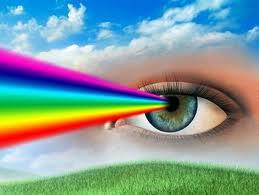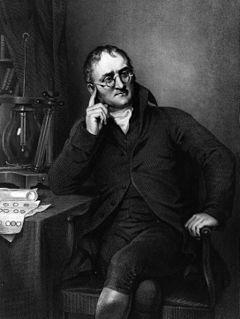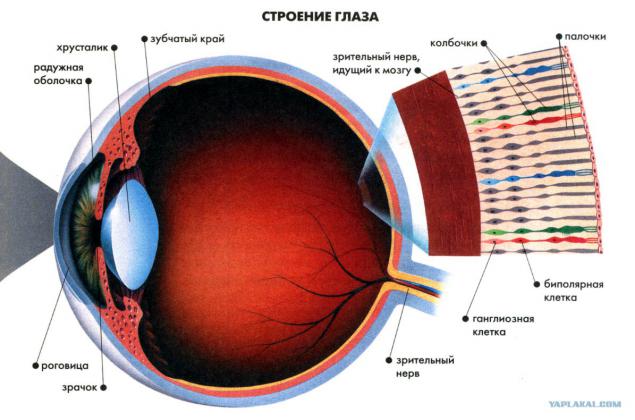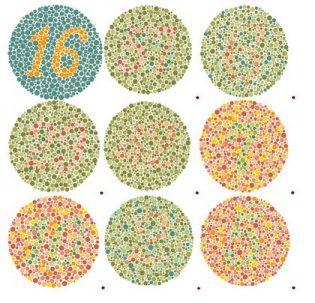Color blindness - impaired color perception
 Bashny.Net
Bashny.Net
The overwhelming majority of sighted people visuals. We perceive visual information, process it and draw conclusions about what they saw. It would seem that it is easier and unambiguously?
But all people are unique, and our own body sometimes gets up a variety of jokes. Let's now talk about those who see colors around not like the others.

There is a beautiful legend that once John Dalton was invited to a party, and one of its conditions was the presence of a gray jacket. Just one such jacket, and it was one of his favorites. Arriving there, he said, to the surprise of others, and his own, was the only one who was not wearing the right color. For his favorite gray jacket turned maroon.
True or not - is not so important.
In fact, John Dalton (incidentally, a very respected scientist who made many great discoveries, Professor at Manchester College, Oxford University, a member of the French Academy of Sciences, the president of the Manchester Literary and Philosophical Society, a member of the Royal Society and the Royal Society of Edinburgh, the winner of the Royal Medal) really up to 26 years and did not know about the presence of this disease itself. Scientists in this issue is not helped study the wardrobe, and the fascination with botany.
He noticed that the flower that day, in the sunlight, seemed to sky-blue, night, by candlelight, looked dark red. Dalton turned to colleagues to find out what kind of an unusual phenomenon he had to watch, but no one except his brother, no magic transformations in the flower did not show. It was then that the Englishman and became suspicious, guessing that his eyesight is something wrong, and that this problem is inheritable. Immediately revealed another mystery became clear reason why Dalton was not able to distinguish between blue flower pink (formerly a scientist is copied to the confusion in the classification of flowers). Naturalist described his condition: "That part of the picture, which others call red, it seems to me like a shadow, or simply poorly lit. Orange, green and yellow hues of the same color appear - from the intense to pale yellow ».

In 1794, soon after arriving in Manchester, Dalton was elected to the Manchester Literary and Philosophical Society ("Lit & Phil") and a few weeks later, has published an article titled "Unusual cases of color," which explains the narrowness of color perception some people bleaching liquid substance eye . Having described this disease by example, Dalton drew people's attention to it, until the moment did not realize at its availability. Despite the fact that the explanation Dalton questioned during his lifetime, a thorough study of their own illness was so unprecedented that the term "color blindness" firmly established for this disease.
Color Blindness, color blindness - inherited, acquired feature less of a man and primates, as expressed in the inability to distinguish one or more colors.

There are three primary colors distinguishable by our eyes. It's red, green and blue.
Color blindness may be partial (relating to the individual colors) or full (associated with all the colors). Complete color blindness is very rare and is usually combined with other serious congenital eye defects. With regard to the partial, there are several varieties of this pathology:
Protanopia - impaired perception of red color - this is the most frequent case of color blindness. Perceived range is shortened to the red end. The red color is perceived darker, mixed with dark green, dark brown and green - with a light gray, light yellow, light brown.
Tritanopia - blue and yellow part of the spectrum is not perceived. Violation is expressed in the absence of color sensations in the blue-violet region of the spectrum. It is extremely rare. When Tritanopia all colors are represented in shades of red or green.
Deuteranopia - partial blindness to green. It is mixed with a light orange, light pink, and red - from light green, light brown.
Anomalies in three colors - less severe disorders associated with impaired ability to distinguish individual colors. People with the most benign forms of such disorders may not even be aware that they have violated color vision. In the case of color perception abnormality distinction between the three colors present, however, the wrong person perceives their shades. For example, marsh color he can see as pure brown. According to doctors, in practice most often confused shades of green, sometimes red and even more rarely blue.
Monohromatizm or achromatopsia. People with such a distinguished feature of a different degree of brightness, but do not see colors. Their world looks like a black and white image. For people with this disorder also characterized by poor visual activity, poor tolerance to bright light, and nystagmus - rapid involuntary eye movements. To monohromatizm inherited, a person must obtain a gene of this disorder from both parents. This is a rare form of color blindness.
By the way, people who have "full" color vision, called normal trichromats.

What is the cause of color blindness? The human retina photoreceptors are called cones, they are responsible for the perception of colors. The cones are concentrated in the central area of the retina, and are divided into three types.
The first of these contains a pigment that is sensitive to the red color (with a maximum wavelength of 552-557 nm), the second - to green (maximum - about 530 nm), the third - the blue (426 nm). Problems are color appear when one (or more) of the pigments is completely absent, it is functionally inoperative or is present in insufficient quantities.
Transfer inherited color blindness is associated with the X-chromosome and almost always passed from mother to son carry the gene, resulting in twenty times more frequently seen in men who have a set of sex chromosomes XY. In men, the defect in a single X-chromosome is not compensated, as "spare» X-chromosome no. Varying degrees of color blindness affects 2-8% of men and only 0, 4% of women.
By the way, mistakenly believing that female carriers are not subject to this condition. Those representatives of the fair sex, which "carry" the gene to pathology, too, have a minor violation of color. Another thing is that in everyday life this defect often did not appear. More serious forms of color blindness in women develop in cases where both parents handed her daughter "affected" chromosome, which is a rarity.

But blindness is not exclusively an innate.
According to the head of ophthalmology course LGU Y. Semenov, the anomaly of color can be acquired. The acquired form is due to diseases of the retina and optic nerve.
In this case, a violation of the perception of color is considered a pathology, but not considered as a separate illness.
Under these conditions people tend to see the world painted in a specific color. For example, after cataract surgery, some patients say that everything around them seems to be bluish. The reason is simple - before the surgery lens yellower, and the world perceived by man in a soft, warm colors. Now, due to postoperative changes, it seemed that the colors around sharply turned cold. In this regard, even in modern medicine apply artificial lenses produced with the addition of yellow. This is done in order to have operated on people did not have the unpleasant sensation of "ice" coldness of the world, and they went to see him in familiar tones.
"I have treated a patient with a disease of the optic nerve, - said Yulia Mikhailovna. - One summer, she drew attention to the fact that all the leaves on the trees yellow - the disease has led to a peculiar pathology worldview. It is not uncommon that people with diseases of the retina or optic nerve see the world in a reddish or greenish color. " It is worth noting that the eye injury does not lead to color blindness, it often affects visual acuity.

To investigate color vision, doctors use a special table. For example, Rabkin polychromatic table. Their principle is quite simple. The picture shows the numbers or symbols, which consist of a set of circles and dots of different colors. The man did not perceive some colors or shades, such a table can see "hidden" character is only part of the main figure. At the same time the very shape or figure he will not see completely. In modern medicine, there are also computer programs and special devices that allow to diagnose problems of color perception. The analogue tables Rabkin is the Ishihara test.
Most often men of color anomaly is detected at the time of passing the medical examination in the military. Color perception is also verified by passing a medical committee to obtain a driving license. People suffering from disorders of color, do not allow to transport management. There are a number of professions where the right color discrimination - need. It railwaymen, sailors, pilots, doctors, chemists, etc.
In Turkey and Romania, people with impaired color vision have not issued a driver's license. In Russia, the color-blind when dihromazii (Protanopia or deuteranopia) can only get a driver's license category A and category B, without the right to employment.
In some European countries, restrictions for color-blind when issuing driver's licenses there.

Blindness first attracted public attention in 1875 when Sweden, near the town of Lagerlunda, was a train wreck, which caused great casualties. Prior to the investigation, which was conducted in this case, was insoluble problem: how to driver (by the way, a miracle survivor and assures that led to the composition of the green) might not notice the red signal semaphore? Attracted to investigate the accident scientist physiologist Professor Alaric Frithiof Holmgren came to the conclusion that it was the cause of color blindness driver. It turned out that he did not distinguish red. Prove it helped investigative experiment: Holmgren showed machinist few skeins of wool in different colors and asked him to name the tone of each of them. Pointing to the red skein, the defendant stated that it - green. On the fateful combination of circumstances, namely the development of transport at the time led to the introduction and spread of color alarm. By the way, it is described a case brought to the fact that in employment in the transport service candidates become mandatory to evaluate the color perception.
And in 1987, German ophthalmologist Wolfgang Muench had diagnosis of 342 artists from Dresden. It was found that the color blindness is the examinee 31 (17 of them due to problems with the perception of color abandoned painting and moved to the graph). Thus, the number of color-blind among the artists represented by the sample was 9%. The most famous artist is color-blind Frenchman Charles Marion (1821-1868 gg.). He was a naval officer and sailed around the world on the corvette "Rhine". There are other examples: in the paintings of Vincent Van Gogh too yellow (though there is a theory that this is only a temporary period due to other causes), and Mikhail Vrubel worked, for the most part, in a pearl gray-scale. It is also proved that the disease and age-related changes in color perception crippled Repin and Savrasov. Funny, but the author Bears bear, mascot XXII Summer Olympic Games held in Moscow in 1980, Viktor Chizhikov - also colorblind.

Let's try to at least roughly to see some pictures of the eyes of people with a different color perception.
1 - normal vision
2. - Protanopia
3. - deuteranopia
4. - Tritanopia

World Map

Sad dog

Speaking of dogs and other our smaller brothers.
Spotting bodies of many species of mammals disabilities colors (often - only 2 colors), but some animals are, in principle, are not able to distinguish colors. On the other hand, many animals are better able to distinguish between the human gradation of the colors that they are important for life. Many members of the order Perissodactyla (in particular, horses) distinguish shades of brown, which appear to be the same person (depends on whether you can have the list); Polar bears are able to distinguish shades of white and gray more than 100 times better than humans (by melting ice changes the color, shade of color can be concluded whether the ice floe will break if it occurred). Some breeds of dogs find the beginnings of color vision.
And of course, as is well known - the bulls do not care what the matador waving a cloth. Experiments conducted by Professor of Zoology, University of Münster Gertie duiker, led to the conclusion that the bulls did not distinguish between red and irritated bull in the arena matador red color and fabric movement as threatening and very matador. As the bulls still short-sighted, the flashing of cloth meant them as a challenge and aggression by the enemy.

Of course, the confusion with the colors in some cases can lead to dire consequences, as we have seen in the case of a train in Sweden. However, not always impaired color vision have a significant impact on daily life. As mentioned, many people find it is already being in adulthood. But what if the colors are not visible at all? Is it hard?
Monohromatizm (sometimes - achromatopsia) - referred to above, as the most rare form of color blindness, which could be called "color blindness". This rare genetic defect occurs in one person out of 33 million.
Monochromat have lost all three (sometimes two) cone mechanism (remember? 3 types of photoreceptors responsible for the perception of color), and the world to them becomes black and white.
When one day, the family had a 6-year-old Caleb Pearman, suddenly became a TV show in black and white, was outraged and began to comment on his family. And only then they realized - Caleb did not notice any difference ... Follow-up visit to the doctor confirmed: Caleb suffers absolute color blindness.
This disorder does not progress with time, and the rest suffering from achromatopsia can be completely healthy. Caleb Perman well at school, engaged in a section of aikido. Also failure to distinguish colors, it inconvenience is another feature - Caleb does not tolerate bright sunlight. Glaring rays cause him pain, so most of the day he is forced to carry out special sunglasses.

English neurologist Oliver Sacks (author of the popular science bestseller "The man who took his wife for a hat") in his next book "The Anthropologist on Mars" tells the story of the artist, as a result of head injury, lost the ability to see the world in color. The man has lost not only the ability to perceive the colors of the world - the brain damage was so severe that he lost his memory and the concept of colors as such. Even his fantasy and dreams become black and white. For a man who wrote a lifetime color pictures, this state has become a drama and led to severe depression.
In response to a story published by Oliver Sacks received a letter from a woman suffering from birth achromatopsia. Mrs. Frances Futterman confessed that did not suffer from his features: because she has never seen colors, did not know she had lost. "Unlike humans, who lost for some reason, color perception, I never worried because of the fact that this perception is deprived wrote Mrs. Futterman. - The world around me is fine without this perception ».
"People say that the world must seem like black and white or shades of gray a host - she adds. - Nothing like that I do not feel. The notion of "gray" for me does not have its true value, as well as the concept of "blue" or "pink" because I have made my own judgment about colors, including blue and pink, but the concept of gray make up failed to ". It is interesting that Mrs. Futterman somehow distinguished colored objects and images from the real black and white. & quot; ... black and white photographs for me too colorless. The world around me is much richer colors than black and white photos or TV shows & quot ;, - she said.
No.
Source:
But all people are unique, and our own body sometimes gets up a variety of jokes. Let's now talk about those who see colors around not like the others.

There is a beautiful legend that once John Dalton was invited to a party, and one of its conditions was the presence of a gray jacket. Just one such jacket, and it was one of his favorites. Arriving there, he said, to the surprise of others, and his own, was the only one who was not wearing the right color. For his favorite gray jacket turned maroon.
True or not - is not so important.
In fact, John Dalton (incidentally, a very respected scientist who made many great discoveries, Professor at Manchester College, Oxford University, a member of the French Academy of Sciences, the president of the Manchester Literary and Philosophical Society, a member of the Royal Society and the Royal Society of Edinburgh, the winner of the Royal Medal) really up to 26 years and did not know about the presence of this disease itself. Scientists in this issue is not helped study the wardrobe, and the fascination with botany.
He noticed that the flower that day, in the sunlight, seemed to sky-blue, night, by candlelight, looked dark red. Dalton turned to colleagues to find out what kind of an unusual phenomenon he had to watch, but no one except his brother, no magic transformations in the flower did not show. It was then that the Englishman and became suspicious, guessing that his eyesight is something wrong, and that this problem is inheritable. Immediately revealed another mystery became clear reason why Dalton was not able to distinguish between blue flower pink (formerly a scientist is copied to the confusion in the classification of flowers). Naturalist described his condition: "That part of the picture, which others call red, it seems to me like a shadow, or simply poorly lit. Orange, green and yellow hues of the same color appear - from the intense to pale yellow ».

In 1794, soon after arriving in Manchester, Dalton was elected to the Manchester Literary and Philosophical Society ("Lit & Phil") and a few weeks later, has published an article titled "Unusual cases of color," which explains the narrowness of color perception some people bleaching liquid substance eye . Having described this disease by example, Dalton drew people's attention to it, until the moment did not realize at its availability. Despite the fact that the explanation Dalton questioned during his lifetime, a thorough study of their own illness was so unprecedented that the term "color blindness" firmly established for this disease.
Color Blindness, color blindness - inherited, acquired feature less of a man and primates, as expressed in the inability to distinguish one or more colors.

There are three primary colors distinguishable by our eyes. It's red, green and blue.
Color blindness may be partial (relating to the individual colors) or full (associated with all the colors). Complete color blindness is very rare and is usually combined with other serious congenital eye defects. With regard to the partial, there are several varieties of this pathology:
Protanopia - impaired perception of red color - this is the most frequent case of color blindness. Perceived range is shortened to the red end. The red color is perceived darker, mixed with dark green, dark brown and green - with a light gray, light yellow, light brown.
Tritanopia - blue and yellow part of the spectrum is not perceived. Violation is expressed in the absence of color sensations in the blue-violet region of the spectrum. It is extremely rare. When Tritanopia all colors are represented in shades of red or green.
Deuteranopia - partial blindness to green. It is mixed with a light orange, light pink, and red - from light green, light brown.
Anomalies in three colors - less severe disorders associated with impaired ability to distinguish individual colors. People with the most benign forms of such disorders may not even be aware that they have violated color vision. In the case of color perception abnormality distinction between the three colors present, however, the wrong person perceives their shades. For example, marsh color he can see as pure brown. According to doctors, in practice most often confused shades of green, sometimes red and even more rarely blue.
Monohromatizm or achromatopsia. People with such a distinguished feature of a different degree of brightness, but do not see colors. Their world looks like a black and white image. For people with this disorder also characterized by poor visual activity, poor tolerance to bright light, and nystagmus - rapid involuntary eye movements. To monohromatizm inherited, a person must obtain a gene of this disorder from both parents. This is a rare form of color blindness.
By the way, people who have "full" color vision, called normal trichromats.

What is the cause of color blindness? The human retina photoreceptors are called cones, they are responsible for the perception of colors. The cones are concentrated in the central area of the retina, and are divided into three types.
The first of these contains a pigment that is sensitive to the red color (with a maximum wavelength of 552-557 nm), the second - to green (maximum - about 530 nm), the third - the blue (426 nm). Problems are color appear when one (or more) of the pigments is completely absent, it is functionally inoperative or is present in insufficient quantities.
Transfer inherited color blindness is associated with the X-chromosome and almost always passed from mother to son carry the gene, resulting in twenty times more frequently seen in men who have a set of sex chromosomes XY. In men, the defect in a single X-chromosome is not compensated, as "spare» X-chromosome no. Varying degrees of color blindness affects 2-8% of men and only 0, 4% of women.
By the way, mistakenly believing that female carriers are not subject to this condition. Those representatives of the fair sex, which "carry" the gene to pathology, too, have a minor violation of color. Another thing is that in everyday life this defect often did not appear. More serious forms of color blindness in women develop in cases where both parents handed her daughter "affected" chromosome, which is a rarity.

But blindness is not exclusively an innate.
According to the head of ophthalmology course LGU Y. Semenov, the anomaly of color can be acquired. The acquired form is due to diseases of the retina and optic nerve.
In this case, a violation of the perception of color is considered a pathology, but not considered as a separate illness.
Under these conditions people tend to see the world painted in a specific color. For example, after cataract surgery, some patients say that everything around them seems to be bluish. The reason is simple - before the surgery lens yellower, and the world perceived by man in a soft, warm colors. Now, due to postoperative changes, it seemed that the colors around sharply turned cold. In this regard, even in modern medicine apply artificial lenses produced with the addition of yellow. This is done in order to have operated on people did not have the unpleasant sensation of "ice" coldness of the world, and they went to see him in familiar tones.
"I have treated a patient with a disease of the optic nerve, - said Yulia Mikhailovna. - One summer, she drew attention to the fact that all the leaves on the trees yellow - the disease has led to a peculiar pathology worldview. It is not uncommon that people with diseases of the retina or optic nerve see the world in a reddish or greenish color. " It is worth noting that the eye injury does not lead to color blindness, it often affects visual acuity.

To investigate color vision, doctors use a special table. For example, Rabkin polychromatic table. Their principle is quite simple. The picture shows the numbers or symbols, which consist of a set of circles and dots of different colors. The man did not perceive some colors or shades, such a table can see "hidden" character is only part of the main figure. At the same time the very shape or figure he will not see completely. In modern medicine, there are also computer programs and special devices that allow to diagnose problems of color perception. The analogue tables Rabkin is the Ishihara test.
Most often men of color anomaly is detected at the time of passing the medical examination in the military. Color perception is also verified by passing a medical committee to obtain a driving license. People suffering from disorders of color, do not allow to transport management. There are a number of professions where the right color discrimination - need. It railwaymen, sailors, pilots, doctors, chemists, etc.
In Turkey and Romania, people with impaired color vision have not issued a driver's license. In Russia, the color-blind when dihromazii (Protanopia or deuteranopia) can only get a driver's license category A and category B, without the right to employment.
In some European countries, restrictions for color-blind when issuing driver's licenses there.

Blindness first attracted public attention in 1875 when Sweden, near the town of Lagerlunda, was a train wreck, which caused great casualties. Prior to the investigation, which was conducted in this case, was insoluble problem: how to driver (by the way, a miracle survivor and assures that led to the composition of the green) might not notice the red signal semaphore? Attracted to investigate the accident scientist physiologist Professor Alaric Frithiof Holmgren came to the conclusion that it was the cause of color blindness driver. It turned out that he did not distinguish red. Prove it helped investigative experiment: Holmgren showed machinist few skeins of wool in different colors and asked him to name the tone of each of them. Pointing to the red skein, the defendant stated that it - green. On the fateful combination of circumstances, namely the development of transport at the time led to the introduction and spread of color alarm. By the way, it is described a case brought to the fact that in employment in the transport service candidates become mandatory to evaluate the color perception.
And in 1987, German ophthalmologist Wolfgang Muench had diagnosis of 342 artists from Dresden. It was found that the color blindness is the examinee 31 (17 of them due to problems with the perception of color abandoned painting and moved to the graph). Thus, the number of color-blind among the artists represented by the sample was 9%. The most famous artist is color-blind Frenchman Charles Marion (1821-1868 gg.). He was a naval officer and sailed around the world on the corvette "Rhine". There are other examples: in the paintings of Vincent Van Gogh too yellow (though there is a theory that this is only a temporary period due to other causes), and Mikhail Vrubel worked, for the most part, in a pearl gray-scale. It is also proved that the disease and age-related changes in color perception crippled Repin and Savrasov. Funny, but the author Bears bear, mascot XXII Summer Olympic Games held in Moscow in 1980, Viktor Chizhikov - also colorblind.

Let's try to at least roughly to see some pictures of the eyes of people with a different color perception.
1 - normal vision
2. - Protanopia
3. - deuteranopia
4. - Tritanopia

World Map

Sad dog

Speaking of dogs and other our smaller brothers.
Spotting bodies of many species of mammals disabilities colors (often - only 2 colors), but some animals are, in principle, are not able to distinguish colors. On the other hand, many animals are better able to distinguish between the human gradation of the colors that they are important for life. Many members of the order Perissodactyla (in particular, horses) distinguish shades of brown, which appear to be the same person (depends on whether you can have the list); Polar bears are able to distinguish shades of white and gray more than 100 times better than humans (by melting ice changes the color, shade of color can be concluded whether the ice floe will break if it occurred). Some breeds of dogs find the beginnings of color vision.
And of course, as is well known - the bulls do not care what the matador waving a cloth. Experiments conducted by Professor of Zoology, University of Münster Gertie duiker, led to the conclusion that the bulls did not distinguish between red and irritated bull in the arena matador red color and fabric movement as threatening and very matador. As the bulls still short-sighted, the flashing of cloth meant them as a challenge and aggression by the enemy.

Of course, the confusion with the colors in some cases can lead to dire consequences, as we have seen in the case of a train in Sweden. However, not always impaired color vision have a significant impact on daily life. As mentioned, many people find it is already being in adulthood. But what if the colors are not visible at all? Is it hard?
Monohromatizm (sometimes - achromatopsia) - referred to above, as the most rare form of color blindness, which could be called "color blindness". This rare genetic defect occurs in one person out of 33 million.
Monochromat have lost all three (sometimes two) cone mechanism (remember? 3 types of photoreceptors responsible for the perception of color), and the world to them becomes black and white.
When one day, the family had a 6-year-old Caleb Pearman, suddenly became a TV show in black and white, was outraged and began to comment on his family. And only then they realized - Caleb did not notice any difference ... Follow-up visit to the doctor confirmed: Caleb suffers absolute color blindness.
This disorder does not progress with time, and the rest suffering from achromatopsia can be completely healthy. Caleb Perman well at school, engaged in a section of aikido. Also failure to distinguish colors, it inconvenience is another feature - Caleb does not tolerate bright sunlight. Glaring rays cause him pain, so most of the day he is forced to carry out special sunglasses.

English neurologist Oliver Sacks (author of the popular science bestseller "The man who took his wife for a hat") in his next book "The Anthropologist on Mars" tells the story of the artist, as a result of head injury, lost the ability to see the world in color. The man has lost not only the ability to perceive the colors of the world - the brain damage was so severe that he lost his memory and the concept of colors as such. Even his fantasy and dreams become black and white. For a man who wrote a lifetime color pictures, this state has become a drama and led to severe depression.
In response to a story published by Oliver Sacks received a letter from a woman suffering from birth achromatopsia. Mrs. Frances Futterman confessed that did not suffer from his features: because she has never seen colors, did not know she had lost. "Unlike humans, who lost for some reason, color perception, I never worried because of the fact that this perception is deprived wrote Mrs. Futterman. - The world around me is fine without this perception ».
"People say that the world must seem like black and white or shades of gray a host - she adds. - Nothing like that I do not feel. The notion of "gray" for me does not have its true value, as well as the concept of "blue" or "pink" because I have made my own judgment about colors, including blue and pink, but the concept of gray make up failed to ". It is interesting that Mrs. Futterman somehow distinguished colored objects and images from the real black and white. & quot; ... black and white photographs for me too colorless. The world around me is much richer colors than black and white photos or TV shows & quot ;, - she said.
No.
Source:
Tags
See also
Playing cards
Where to fly multicopter? Technology Roadmap
Card games
How much can you drink, the next day to get behind the wheel?
Birthday Mastdayki
Tovarisch
The beauty of our Earth
10 of the most amazing people (30 photos)
13 most "terrible" parasites of the planet (15 photos)

















